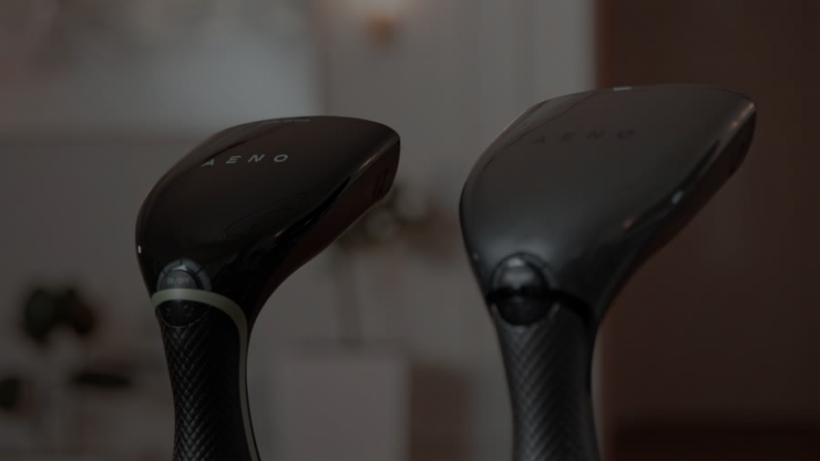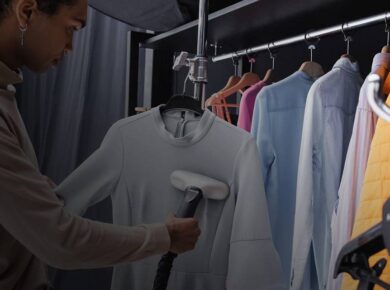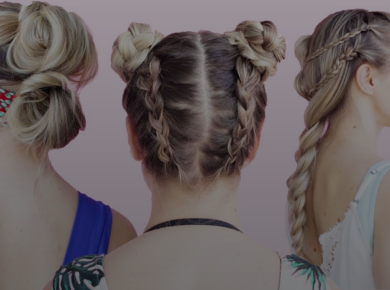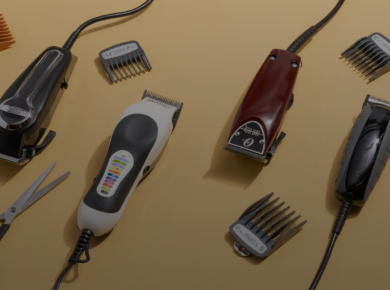It’s morning, and you’re getting dressed for work, but instead of pulling a crisp t-shirt from your wardrobe, you see a crumpled mess of fabric. Sounds familiar? Meet the clothes steamer, a handy electrical appliance that uses water steam to disinfect, de-wrinkle, and smooth out a wide range of fabrics, even delicate textiles like wool and silk. In this in-depth guide to clothes steamers, we’ll explain how steamers work, pinpoint the main factors you should pay attention to when shopping for the appliance, and provide you with pro steaming tips to help you create a professional appearance you can take pride in.
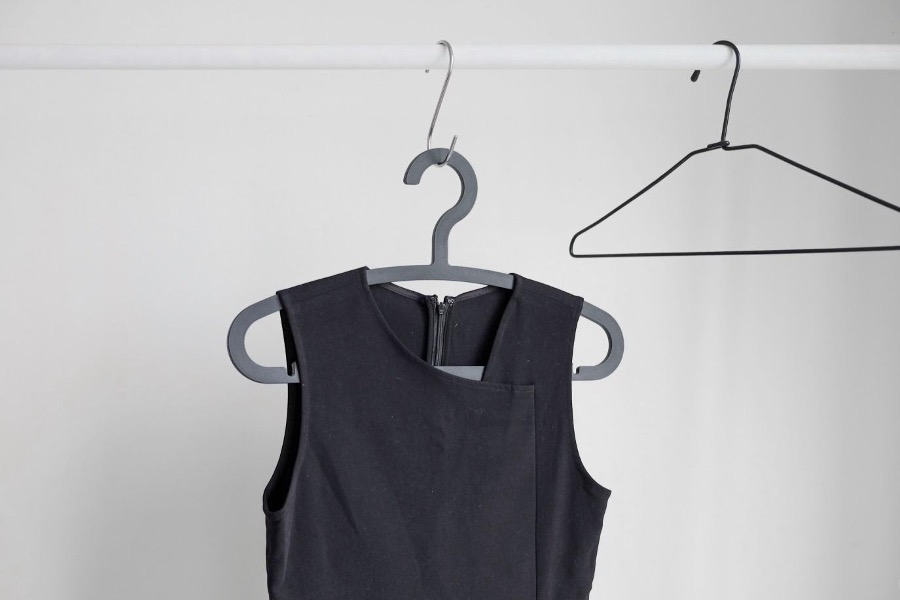
How Does a Clothes Steamer Work?
Today, clothes steamers typically come in handheld and vertical varieties with cloth hangers: the former feature smaller water tanks, which make them suitable for traveling or smaller de-wrinkling sessions. At the same time, the latter are tailor-made for larger clothes loads.
Whether you’re considering a portable or upright steamer, the devices consist of a water tank, a heating element, and a nozzle. The principle behind using a steamer is relatively simple: after adding water to a tank, the heating element warms it up until it becomes vapor, and you can apply the steam to the wrinkled garment through a directional nozzle. Unlike irons, steamers are not precise: they are used simultaneously for larger areas, which accelerates and simplifies your work.
Steamer vs. Iron
Although steamers and irons have a similar function, each appliance comes with a set of unique benefits. Many people are typically unsure which one to choose: should you commit to one of the devices or invest in both? In reality, steamers and irons are not interchangeable, and the answer to the dilemma lies in your preference and the result you want to achieve.
Irons
From enhancing your professional appearance to preserving fabric quality and killing germs, ironing comes with many benefits. Irons are typically heated up to 180–220 °C, a perfect temperature for most clothes, although the devices have up to seven heat settings where one is the coolest and seven is the hottest, making them perfect for heavyweight cotton.
Whether you’re ironing curtains or dress pants, irons leave them with crisp, sharp edges. Most modern irons come with built-in steam features: the vents release the steam onto the fabric, which allows for softening and pressing the clothes more effectively.
Pros:
- Irons can target specific areas, which makes them perfect if striving for a crisp, sharp look.
- These appliances typically have from one to seven heat settings and steam vents, making them suitable for a wide range of clothes, from nylons to heavy bedding.
Cons:
- Require an ironing board.
- Not exactly portable or suitable for traveling.
- Can’t tackle more structured and embellished fabrics with beads or sequins.
Steamers
Are you tired of the ironing board hogging the precious space? Unlike irons, steamers are multifunctional and target a larger area. They are ideal for de-wrinkling clothes and tackling upholstery, curtains, toys, bedding, and a range of home furnishings. Delicate, heavier, and structured garments, like jackets, complex knits, and clothes embellished with sequins and beads, will also benefit from a session with a steamer. Most modern steamer models are extremely maneuverable, so you can steam away in horizontal and vertical directions without worrying about water spillage.
Pros:
- Works on the wider area simultaneously.
- You don’t need much time to set it up for quickly refreshing or de-wrinkling.
- Doesn’t require you to remove hanging draperies to work out the wrinkles.
- Portable and travel-friendly.
Cons:
- Steamers require constant refilling, depending on the water tank size.
- You won’t achieve a sharp, crisp look.
Overall, when choosing between an iron and a steamer, consider your preferences and clothes. If you wear more structured fabrics and want to get the job done in minutes, go for a steamer. On the other hand, if you prefer to get that clear-cut, crisp look and don’t mind the ironing board and extra hassle, consider purchasing an iron. The bottom line is that a steamer is not better or worse than an iron; it’s just different.
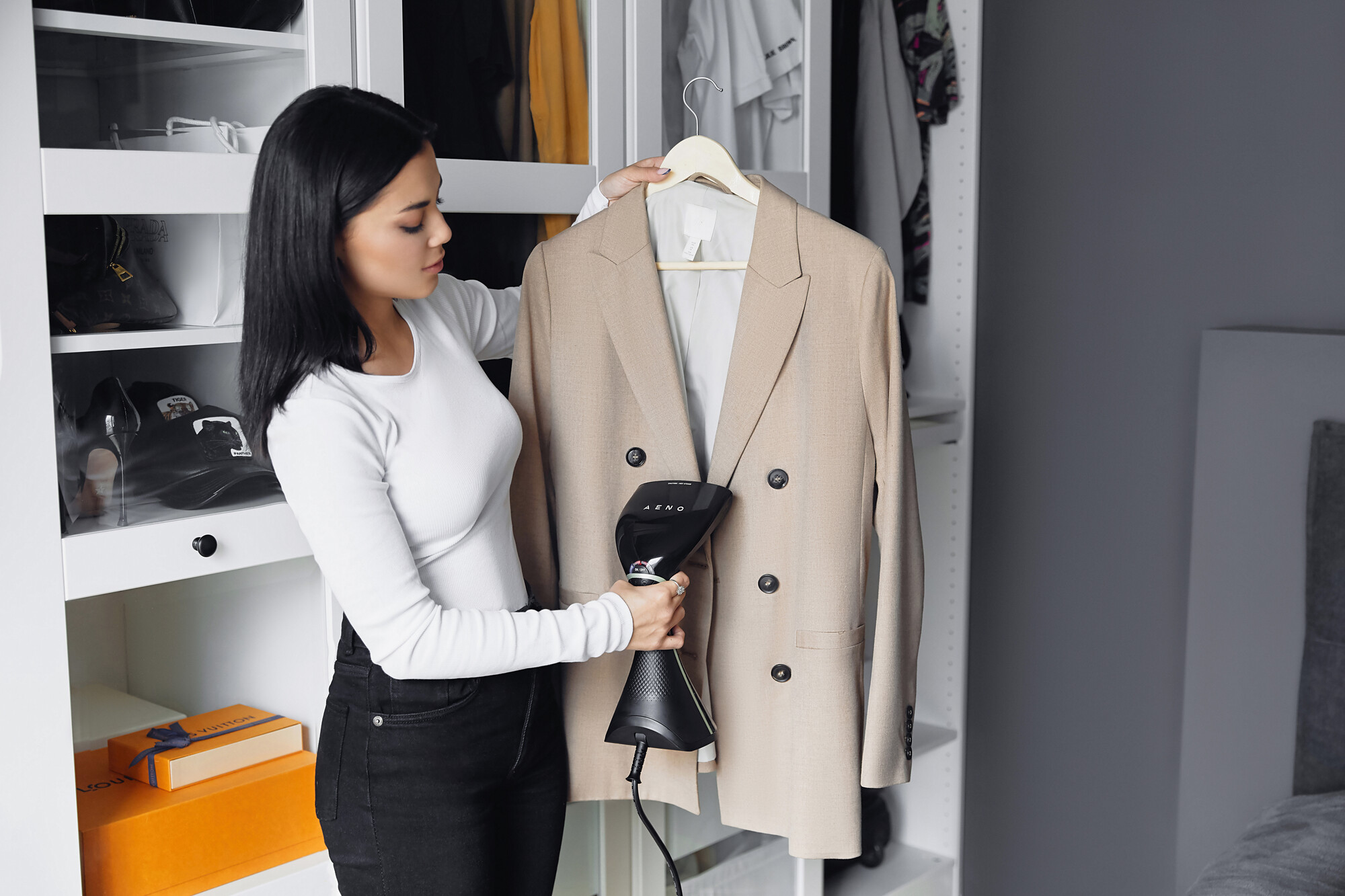
Pro Steaming Tips for Absolute Beginners
In the right hands, a steamer transforms into a multifunctional device capable of smoothing and sanitizing any type of fabric. De-wrinkle your clothes like a pro with this compilation of the best tips and tricks on how to use the steamer to its maximum capacity.
1. Use Your Steamer Correctly
Steaming is more than moving the device back and forth; there is a technique that will allow for maximizing your efforts. Here’s a step-by-step brief on how to use a hand steamer manual to start you off:
- Step 1. Hang the garment you plan to steam on the hanger. Vertical steamers are typically equipped with a hanger, while handhold steamers require you to get a bit more creative.
- Step 2. Fill out the water tank of your portable or upright steamer. You can use tap water, as long as it’s soft or distilled. This will allow you to prolong the lifespan of your device and avoid clogging the steamer with minerals. Avoid filling the water tank up too full.
- Step 3. Plug in the steamer and wait until it heats up. They are typically ready to use in about three minutes, depending on the model, with some brands boasting their devices are ready to go in half a minute.
- Step 4. Hold the steamer upright a couple of centimeters from the clothes. There should always be a small gap between the device and the fabric to avoid any potential damage. Start gliding it from top to bottom of the garment in a gentle sweeping motion. For a better result, grab the bottom hem and gently stretch it to minimize wrinkles and creases.
- Step 5. Let your clothes air dry. Leave your garment to hang or lay it on a flat surface for up to 10 minutes. This time is sufficient for letting all the residue moisture evaporate.
2. Clean Your Device Regularly for Optimal Performance
Regular maintenance will keep your steamer at top performance for years to come. Store it in a cool, dry area, and regularly clean the water tank to combat mineral buildup, especially if using hard tap water. To clean the tank, you’ll need cleaning vinegar or distilled white vinegar. Word of caution: avoid using flavored vinegar because its sediment will leave your device worse to wear. Here’s how it works: fill the water reservoir with distilled white vinegar, power up the steamer, and blast the steam until nearly empty. Refill the tank with water and repeat the process. Clean the steamer every couple of months.
3. Steam from the Inside
If you want to de-wrinkle thicker fabrics, remove creases from your button-up shirts, or tackle extremely wrinkled clothes, try steaming them from the inside. This effective technique is a great way to achieve a wrinkle-free look. Another workable technique requires you to gently stretch the fabric from the bottom hem while steaming; this will allow for a sharper and crisper look, typically associated with the iron.
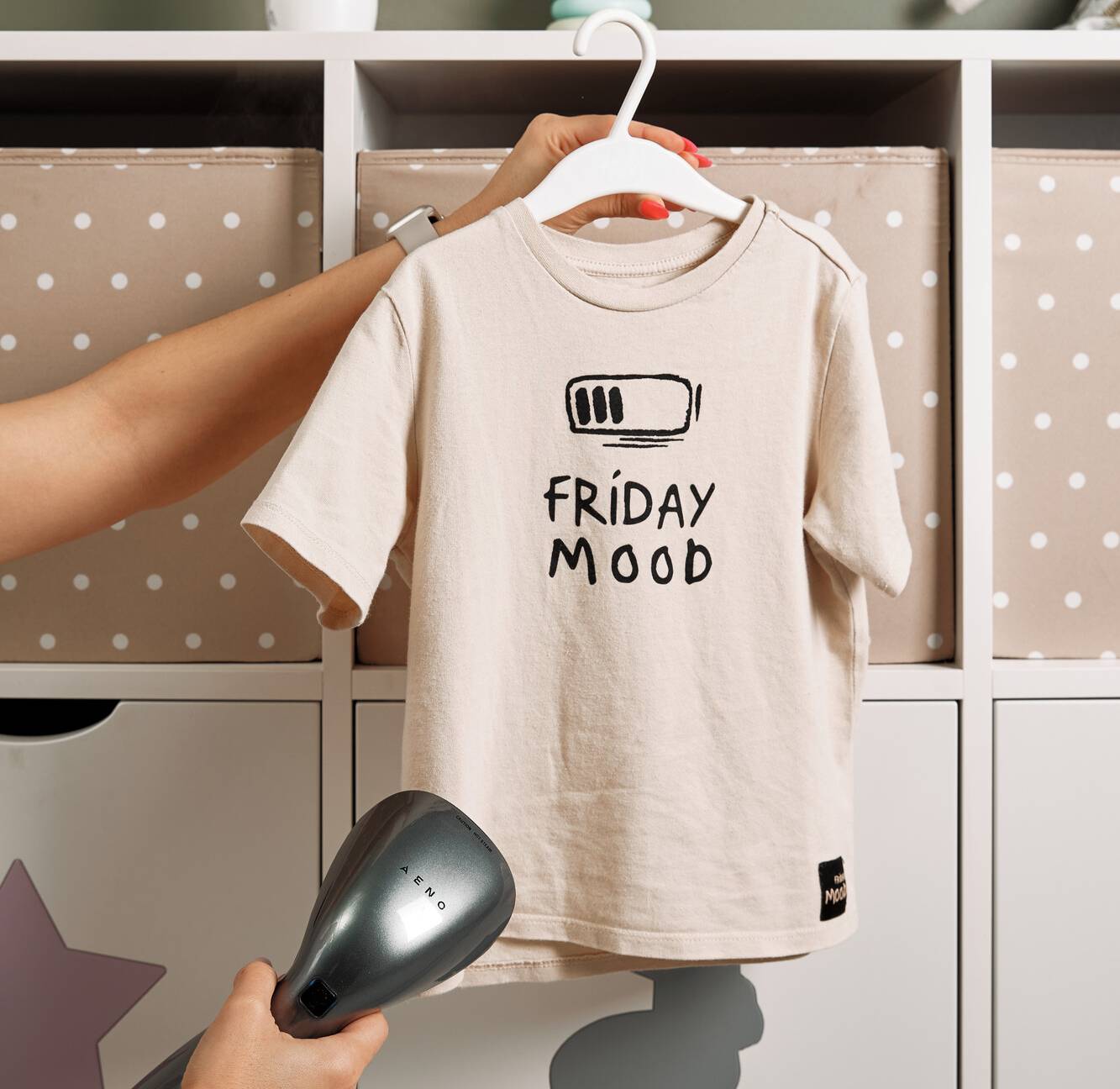
4. Try Steaming Horizontally
Another way to get the wrinkles out of your garments, especially in the pesky areas near collars and cuffs, is to steam them horizontally. By lying the clothes on a flat surface (with another fabric or towel underneath), the slightly damp garment will get extra support, which will help minimize tough creases. Think about it as a spur-of-the-moment ironing board.
5. Don’t Steam Suede or Leather
Before applying a steamer to anything remotely wrinkly, pay attention to the fabric type because not all are steam-friendly. For instance, plastic-related clothes, waxed fabrics, suede, and leather will not only stain but deform or even melt.
Buying Tips on Choosing a Clothes Steamer
Choosing a perfect steamer may sound straightforward, when, in reality, it’s more like a road paved with small challenges. What type of device should you choose, is the more powerful steamer always better, and should you splurge on additional accessories? Let’s figure it out.
1. Steamer Types
Selecting the steamer type is the most important buying decision to make. Steamers are generally divided into:
- Handheld. The portable, compact, and light appliance is perfect for entry-level users, travelers, and those who prefer to quickly de-wrinkle and refresh clothes with minimum hassle. Handheld steamers have limited water tanks, suitable for handling smaller loads.
- Vertical. The heavy-duty, upright steamers have a large water tank, a long nozzle, and a hanger. Unlike handheld models, the steam output is stronger, and the water tank capacity is larger. If you’re planning to de-wrinkle suits, curtains, dresses, and a load of other clothes, consider investing in an upright model.
2. Steam Flow Rate
The amount of liquid transformed into vapor per minute is called the steam flow rate. This indicator correlates with how efficiently the device combats creases and wrinkles. When choosing a steamer, opt for a higher steam output for quicker wrinkle removal.
3. Power
Wattage is the power of a steamer; the higher the power, the faster the heating and flow rate. Steamers exist in a power spectrum, with less powerful models having 500 watts and more powerful ones boasting up to 2,000 watts. The optimal range for a home clothes steamer is between 1,000 and 2,000 watts.
4. Water Tank and Autonomy
The bigger the water tank capacity, the longer you can use the device without refills. Handheld steamers have smaller tanks, while upright models feature bigger ones, which allow steaming more clothes in one go.
5. Accessories
From crease attachments and extra hangers to supplementary fastenings, many steamer models come with a wider range of accessories, promising to maximize versatility and the device’s de-wrinkling properties to the max.
6. Additional Options
When selecting a steamer, safety should be among your top considerations. The auto shut-off feature automatically turns off the device to prevent overheating and clothes damage. This feature is crucial in any handheld garment steamer.
The continuous steam option is another bonus feature that can boost your steaming sessions. Just click the steam button and release it — the device will continuously produce vapor without any interference on your behalf. Just move the steamer from the top to the bottom in a gentle sweeping motion; no need to hold the trigger throughout the entire session.

Conclusion
When it comes to disinfecting, smoothing out fabric, and de-wrinkling clothes, steamers are in a league of their own. The handy electronic appliance is a must-have for anyone who values a wrinkle-free, crisp appearance. Understanding how does streamer work and incorporating all the steaming tips into your routine is essential for minimizing creases and wrinkles. Although choosing the most suitable device requires some time and effort, understanding the differences between the steamer types, steam flow rates, and wattage is a worthwhile endeavor that will allow you to find the most suitable option for your buck.
Want to BUY this product?
Check out retailer list for your country.
